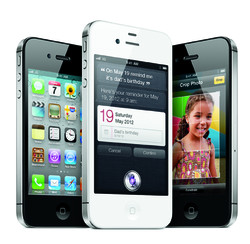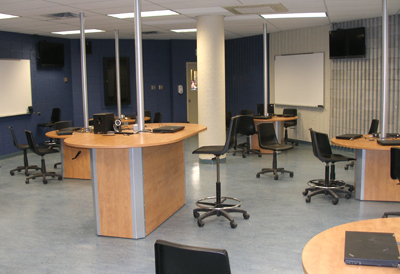iPhone replaces the iPad to support Active Learning
As we observe more and more teachers using the iPad in the classroom, I started to explore the use of an iPhone instead of an iPad and/or a PC for facilitating active learning in the delivery of business and management courses.

The iPhone 4s – image used with permission
The Challenge
I started using my iPhone 4S in the classroom to teach the Retail Management students in the Sports Marketing and Management (SMM) program at Champlain Saint-Lambert CEGEP at the start of the winter 2012 term. Retail Management includes many business areas ranging from store operations and merchandising to logistics.
My first challenge in teaching the course, was to quickly introduce the many areas of the retail industry and related careers not through a traditional lecture, but through an active learning (AL) team exercise.
The Setting
The equipment, software and setting of the Champlain AL Classroom have been well designed and integrated. On the one hand, the students benefit from several group-work areas that are equipped with round tables, laptops, and whiteboard-flat screen pairs. These comfortably accommodate 7 teams of 3 or 4 students each. The whiteboards are standard 4 x 6 panels and the flat screens are Sony 40″ HD displays. On the other hand, the professor’s work area is located in the center of the room, with a multi-media projector attached to an Apple TV (second generation) through an HDMI input.

The Active Learning Classroom at the Saint Lambert Campus of Champlain College
The Apple TV (2nd or 3rd generation) supports an Airplay Mirroring function, that permits the professor to circulate among teams and show everyone on the large main screen wirelessly exactly what is on his/her iPhone or iPad screen. Note that the Airplay Mirroring function is only available for the iPhone 4S, and the iPad 2 or later models (go to Apple’s website for the steps of enabling AirPlay Mirroring).
For the AL exercise, my objective was to integrate the benefits of the AL approach with the technology provided in the Champlain classroom. In preparation for such an exercise, my first instinct was to visit SAP.com and search for a web page that would list several retail software modules in one single page. My selected web page had an overview of multichannel retailing software and a list of close to a dozen related business processes with links to detailed retailing process descriptions.
The Assignment
The assignment was very simple… I asked each of my six teams to prepare a class presentation on one of the retail business processes described in the SAP site. Each team had 20 minutes to prepare its whiteboard presentation and 2 minutes to deliver its class presentation.
I started the exercise with a brief presentation introducing the topic of Retail Management and the goals and requirements of the AL exercise. This presentation consisted of a few PPT slides and a walk through the SAP site. Indeed, throughout the class time everything was displayed on the large screen wirelessly from my iPhone 4S, rather than using a laptop. This was facilitated, since; I already had stored my introductory PPT in the DropBox App on my iPhone and used the QuickOffice PRO App together with Apple TV.
At the start of the team presentations, all students were invited to watch each presenting team by standing up close to the team white boards. On my part, I filmed each team’s white board presentation with my iPhone camera. My goal was to provide not only a summary of topics, but also feedback on the presentations. I therefore concluded the activity by displaying selected video clips of the team presentations, commented on key topics on which to focus and suggested improvements.
This AL exercise was rewarding on many levels. First, combining Champlain’s state-of-the-art AL classroom with smart phone technology improved the professor/student interactive experience dramatically. From my perspective, it allowed me to have more direct contact with my students. On their side, the students became more involved and motivated since their work was displayed on the large screens and their presentations were shown and recorded for posterity.
Student explanation of mobile point of sale
The Results
Second, content-wise the students were also motivated to quickly find out that Retail Management involves much more than store operations. It involves many complex business processes and may lead to a variety of career opportunities.
Third, my teaching tools have been expanded. Rather than just relying on a laptop or a desktop PC, I now have the flexibility of circulating in a classroom with an iPad or an iPhone and quickly switching among different media including PowerPoint, instant video clips and pre-recorded educational videos.
Without a doubt, one of the most valuable lessons is that facilitating active learning does not necessarily require expensive and/or complex educational technology. Overall the AL environment resulted in an improved classroom experience for all participants.


